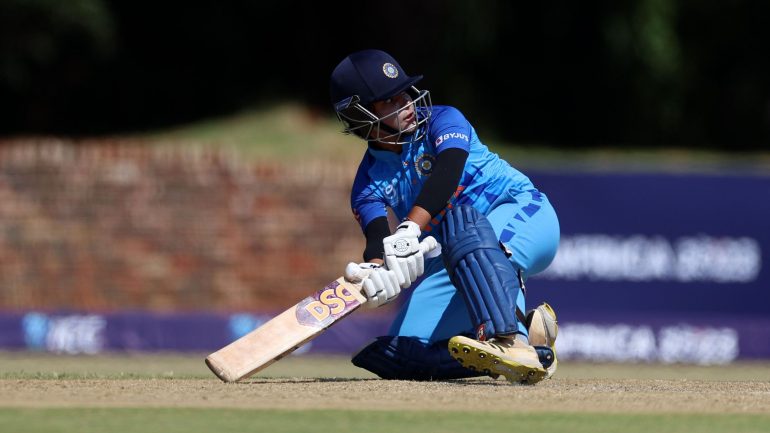When it comes to international competitions, the regulations can cause concern.
In the case of the inaugural Under 19s World Cup let’s hope the more regulations there are, the less confusion they will bring. Which is another way of saying: the regulations for the Super Sixes take up several lengths of parchment. Somebody did a lot of deep thinking about all the permutations possible in a game of cricket.
Terms like NRR (net run-rate) are easily understood if you’re lucky enough to be a maths scholar.
The one positive in using North Western South Africa as the base is the lack of rain. In the past that has caused a lot of pain to teams suffering its effects.
By the end of the Super Sixes (two groups of six = twelve teams), the top two in each qualify for the semi-finals. The highest placed in each group meets the second placed from the other group.
As of 23 January the two tables look like this:
Group One Points
India 6
Australia 4
South Africa 4
Bangladesh 4
Sri Lanka 0
UAE 0
Group Two
England 6
New Zealand 6
Pakistan 2
West Indies 2
Rwanda 2
Ireland 0
Plenty of fixtures remain, but the likeliest semi-finalists already stand clear at the top of the two groups: India, Australia, England and New Zealand.
No great surprise there, only disappointment that a less predictable face couldn’t shine through. Bangladesh had achieved the seemingly impossible by beating Australia in the curtain-raiser, but maintaining the highest standards is another matter.
Exposure to the big time will now be one of the decisive considerations. Of those four only the New Zealanders will be lacking; that is, playing in major competitions, in front of large crowds and inquisitive cameras. But your average Kiwi is made of tough material.
If you can trust cold statistics, then take a look at the one the analysts love above all, NRR. At least it reveals who is scoring the most runs at the crease while conceding the fewest in the field.
Here England stand head and shoulders above their rivals:
England +5.200
New Zealand +4.160
India +2.844
Australia +2.210
Now the comeback: so much depends on the comparative strength of all six sides in a single group. In Group B England and NZ had things all their own way. In Group A competition was tighter.
Here’a second approach, the totals the four sides have reached:
Australia 130; 65-1 (to win); 159-5; 88-3 (to win); 109-4 (to win)
England 199-4; 156-7; 183-5; 207-2
India 170-3; 219-3; 151-4; 87
New Zealand 77-0 (to win); 75-1 (to win); 72-0 (to win); 99-6 (to win)
NZ’s totals show clearly the drawbacks of a competition like this. Only once has their batting been put to the test. If their bowling attack demolish every opponent for under 100 every time, they’d be laughing all the way to the trophy. But they haven’t been properly tested yet.
The selectors saw the problem and radically altered the batting-order for their fourth game, against Rwanda. But now only Emma Mcleod produced the goods with 59; six wickets fell in short order as they chased another total under 100.
At the other extreme, India have put up three large scores, only to succumb cheaply to the Aussies.
It’s no surprise to see batting openers dominating the scene. Under 19s haven’t reached the stage where the selectors can refine their batting order. The strongest bats tend to open proceedings.
The biggest contest at that level must come between India’s Shweta Sehrawat and Shafali Verma and England’s Grace Scrivens and Libby Heap. All four have been in rich form.
Of those four likeliest finalists Australia have already beaten India by seven wickets. That may appear decisive, but it’s perfectly possible for the wheel to turn the other way, espcially in the T20 format.
England and New Zealand have not yet met. At least that adds anticipation to a potential contest.
The Pitches
The question of the pitches to be played on must rear its head. Three venues have been used: the North-West University Oval and the JB Marks Oval, both in Potchefstroom, and two grounds at Willowmore Park, Benoni.
The unrelenting sequence of games has put a huge strain of the curators and their staffs to ensure each match is played under optimum conditions – or, in this case – above optimum conditions. Previous tournaments of a similar size have revealed shortcomings. Pitches have got slower and slower.
Curators have not had the time and space to ensure the best possible preparation for every game.
The good news is, up to now this tournament has proved a triumph for groundsmanship.
With stakes at their highest, nobody wants to see unlucky dismissals caused by an irregular bounce.
We of the Extra B XI may be all used to such conditions; teenagers playing for their nation must be spared them.
The four last matches are all destined for the JB Marks Oval: England’s game with the West Indies, then the semis and the final.
A Reminder
The semis take place on Friday 27 January; the final on 29 January









